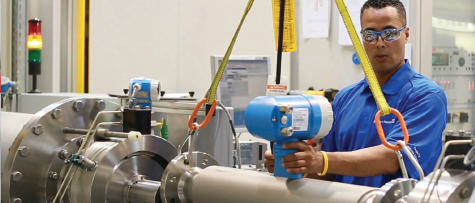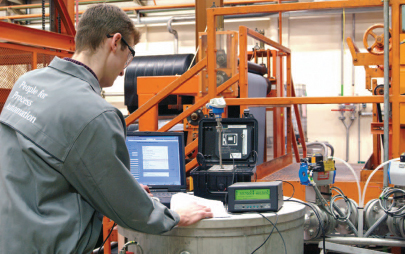- By Nathan Hedrick
- Automation Basics
Summary

A plan determines when instruments need to be calibrated, saving time and money by eliminating unnecessary work
By Kyle Shipps and Nathan Hedrick

In many process plants, instruments are calibrated annually, or based on some other time-based criteria. New instruments and technologies, combined with careful planning and study, allow plants to calibrate instruments at an optimal frequency, for improved operations and cost savings.
In some cases, instrument calibration is determined by industry regulations. In the water and wastewater industry, for example, typical flowmeter requirements are:
- Flowmeters have to be verified at regular intervals.
- Verification has to be performed by a qualified third party and with an accepted inspection method that is based on quality regulations such as ISO 9001.
- A test report needs to be provided for documented proof of verification.
In the pharmaceutical industry, quality risk management has become a mandatory regulatory requirement for drug manufacturers. The Food and Drug Administration (FDA) and the European Medicines Agency (EMA) publish guidelines and requirements for process instrumentation. Guidelines such as "Process Validation: General Principles and Practices," by the FDA, and Annex 15 issued by the EMA offer input to help drug manufacturers manage instrumentation correctly.
The chemical industry has requirements for proof testing per IEC 61508 and IEC 61511, while the oil and gas industry must adhere to contractual agreements between buyer and seller, while also complying with government agency mandates. For example, a company producing oil from a well under an agreement with the Bureau of Land Management or other property owner may have to prove flowmeters at a determined frequency.

Traditional practice drawbacks
Because measurements are so critical to many processes, the traditional industry standard is to calibrate annually, even though it might not be necessary. For most companies, annual calibration is performed as a traditional ritual with no scientific basis, other than being the longest duration of time they are willing to risk.
In many instances, yearly calibrations are not necessary. For example, some flowmeters require calibration only once every three or four years depending on the process fluid, operation, and criticality. In other cases, instrumentation may require calibration much more frequently, possibly monthly, to maintain a safe, efficient, or regulatory-compliant operation. It is also important to realize that calibration intervals are not always fixed and may fluctuate based on usage and other factors.
The first step to addressing these and other issues is an assessment.
A plantwide assessment of all instrumentation to identify and make a list of all instruments is the first step in a calibration plan. This list should also include details such as description, location information, operating conditions, working range and history, and any other items that provide a better understanding of the instrument and system function.
Users should then identify which instruments are critical to the application, the environment, and operator safety. The quality, metrology, maintenance, and automation groups should pool their knowledge of the process environment, the condition of the installed instruments, the type of maintenance work carried out, and any limitations imposed by the plant in terms of servicing. The group should assess each instrument and ask: "Does this instrument have an impact on the quality of the product, on process functionality, or on operator safety?"
The next step is to create a calibration plan, taking all the above factors into account.

Assigning calibration criticality
All instruments should be assigned to one of four categories, ranging from critical to noncritical. The first category-instruments critical to the product-are those affecting product quality or regulatory compliance. These instruments have a direct link to company profits, whether regarding measurement of ingredients in food processing, mixing of chemicals, custody-transfer, or other critical applications.
The next category-instruments critical to the process-are those that can upset the overall plant or other processes, such as shutting down the entire process. The failure of an instrument in this category could cause inefficiencies and production losses but have no direct effect on product quality or safety.
Instrumentation critical for safety has a direct impact on operator safety, equipment protection, and/or the environment. These instruments do not necessarily have to be extremely accurate, which lessens their criticality with respect to calibration, but they certainly have to work properly and reliably.
Finally, noncritical instruments have no impact on product quality, the overall process, safety, or the environment. These types of instruments are typically only used for local or remote monitoring, or when manual operations are performed.
After all instrumentation has been identified and classified into these four categories, a maximum permissible error (MPE) is assigned to each device. MPEs define the tolerance for each function being measured. A critical instrument will usually have a more stringent MPE than a noncritical one.
Over time, most instruments will experience slight accuracy degradation due to aging and simple wear and tear on mechanical components. This needs to be considered when establishing the MPE.
If you can show an auditor or other responsible entity that a noncritical instrument has no effect on product quality, safety, or the environment, then you can claim there is little or no need for periodic calibration. Conversely, you may need to calibrate critical instruments more often than annually to maintain product quality, process operation, or safety.
The instrument manufacturer can help determine factors to keep in mind when defining MPEs, and it can help assess the plant's installed base. It can also help define ideal calibration intervals.

Some asset management systems allow access to instrument information by mobile devices. This maintenance technician gets the data he needs to troubleshoot the level instrument on this tank.
Managing instrument data
Data from the installed base analysis should be stored in an asset management, maintenance management, or instrumentation management software program. One of the major advances in recent years has been the development of instrumentation management software. These systems contain information such as spare parts lists, drawings specific to the instrument, original calibration data, and certificates.
All instrumentation is calibrated by each manufacturer before delivery to the customer, and this calibration data is easily entered into asset management software. Afterward, when a device is recalibrated, its calibration history can be updated and automatically loaded into the asset management system.
In many cases, modern instrumentation equipped with advanced diagnostics can determine if a problem exists, and condition monitoring or other software can inform the maintenance department via an alarm if a particular device is having problems. This diagnostic data also feeds into the instrument management software, where operators, engineers, and maintenance personnel can review it remotely.
For example, diagnostic data from a Coriolis flowmeter can include empty pipe detection, sensor drift, sensor error, electronics error, inhomogeneous mixture error, and ambient and process temperature errors. This data can be used to optimize calibration, diagnose problems, and detect minor issues before they grow into substantial problems.
In addition, many flowmeter technologies are incorporating built-in verification methodologies to qualitatively ensure and document instrument health. When these verification methodologies are traceable, they can be used to supplement the calibration plan.
Another recent advance gives access to the information in an asset management system via mobile devices. From the field, a technician can pull up the calibration history, diagnostic data, troubleshooting instructions, and other information needed to properly diagnose an instrument issue.
Deciding when to calibrate
Calibration frequency depends on the MPE, the nature of the product being measured, the need for clean-in-place (CIP) operations, the severity of process impacts, the type of instrument, and other factors. In some cases, it may only be possible to access an instrument during a complete process shutdown; in other cases, an instrument might be completely accessible for calibration.
Considering the cost of each calibration-which may involve shutting down a process to allow removal of the instrument, taking it to an accredited calibration facility, reinstalling it, and starting up the process-it is wise to combine the calibration plan with a plan for spare parts and replacement instruments.
Thanks to advances in diagnostics and instrument management software, setting up an instrument calibration plan based on best practices is much easier than in the past. Once set up, the calibration plan will improve operations and save money by making sure all instrumentation is calibrated only when necessary.
Reader Feedback
We want to hear from you! Please send us your comments and questions about this topic to InTechmagazine@isa.org.


